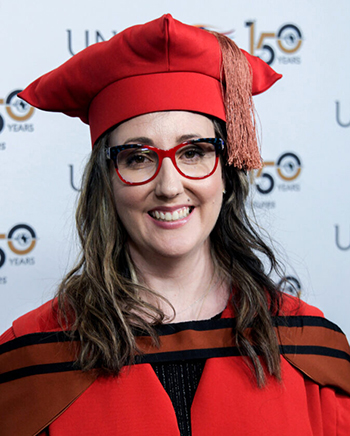
Equipped with state-of-the-art laboratories that provide students with hands-on experiences to bridge theory and practice
On 26 October 2023, Professor Samantha Gildenhuys, of the Department of Life and Consumer Sciences in the College of Agriculture and Environmental Sciences, delivered her virtual inaugural lecture, entitled “Decoding protein function”. In the lecture she briefly shared her academic journey, discussed her research focus at Unisa, and outlined the future direction of her research.
Academic journey

Prof Samantha Gildenhuys
Gildenhuys began the lecture by sharing her experience at an open day at the University of the Witwatersrand, where she first saw an image of the protein structure of the Glutathione S-Transferases enzyme. That is when she knew she wanted to pursue a BSc degree, majoring in genetics and biochemistry.
Having completed a BSc Honours, she embarked on an MSc focusing on protein folding – a study which was subsequently upgraded to a PhD. This was followed by a postdoctoral fellowship at the University of the Witwatersrand. A grateful Gildenhuys acknowledged the many individuals who played a vital role in her career progression to full professor.
As Gildenhuys explained, her research focus on proteins involves investigating how they function and can be manipulated. Viruses are non-living entities that contain some form of code or genetic material, which specifies how to produce more of that virus. To do so they require host cells which they infect, causing disease. Their viral packaging is protein and, in some cases, lipid layers that protect the virus genome and allow it to enter cells. Rotaviruses are non-enveloped viruses that have no lipid layers. Only three protein layers protect their genome and ensure that the virus enters a cell and reproduces.
Gildenhuys stated that, to better understand rotavirus proteins, it is crucial to analyse their sequences. Her first published work on rotaviruses dealt with the three virus proteins, VP7, VP6 and VP2, and specifically their sequences, identified over time by researchers from across the world.
“To study the proteins,” she said, “a production system must be engineered, so essentially you use a plasmid to transform the bacterial cell. This plasmid contains the code for the protein you wish to produce, as well as a switch code that can be activated, when appropriate, to produce the protein. Once produced, the protein must be purified of all the bacterial cell components prior to being studied or used.”
Gildenhuys added that once proteins are obtained one needs to determine how they might act in the virus or in a formulation for say a vaccine. VP7 Bluetongue virus was produced using a bacterial system and tested to see how its structure altered in the presence of possible vaccine formulation additives, namely sodium chloride and glycerol, to determine their effect on the stability of the protein.
Future research
Gildenhuys concluded her lecture by revealing that her future research will revolve around identifying compounds that can modify the different virus proteins she is studying – compounds that might lock the proteins in certain positions or structures. That would allow the proteins to display key epitope regions to the immune system – without being part of a full virus particle – as part of a subunit vaccine. The binding of certain compounds could also prevent the proteins from carrying out a key function, thus helping to cure an infection. Studying how proteins interact with compounds will also provide further details about the key residues and surfaces which proteins use to carry out their tasks, and how these can be manipulated or used in other applications.
Supervision
“Supervising postgraduate students is a very important task, as it entails guiding a student to develop skills that will make him or her successful,” noted Gildenhuys. “These skills are not solely confined to laboratory techniques or research techniques, but also the soft skills they need to develop. Just as each student is unique, so each supervision journey is unique.”
Gildenhuys has supervised two postdoctoral fellows, co-supervised eight MSc and PhD students to completion, and 24 BSc Honours students’ mini-research projects.
She concluded: “I am happy that many of these students have either entered the industry or studied further, so I think I succeeded in capacitating them to a level where they could advance their careers, in line with their abilities and interests. So many significant research outputs have emerged from the projects which the students completed or are in the process of completing.”
* By Gugu Masinga, Communication and Marketing Specialist, College of Agriculture and Environmental Sciences
Publish date: 2023-11-09 00:00:00.0